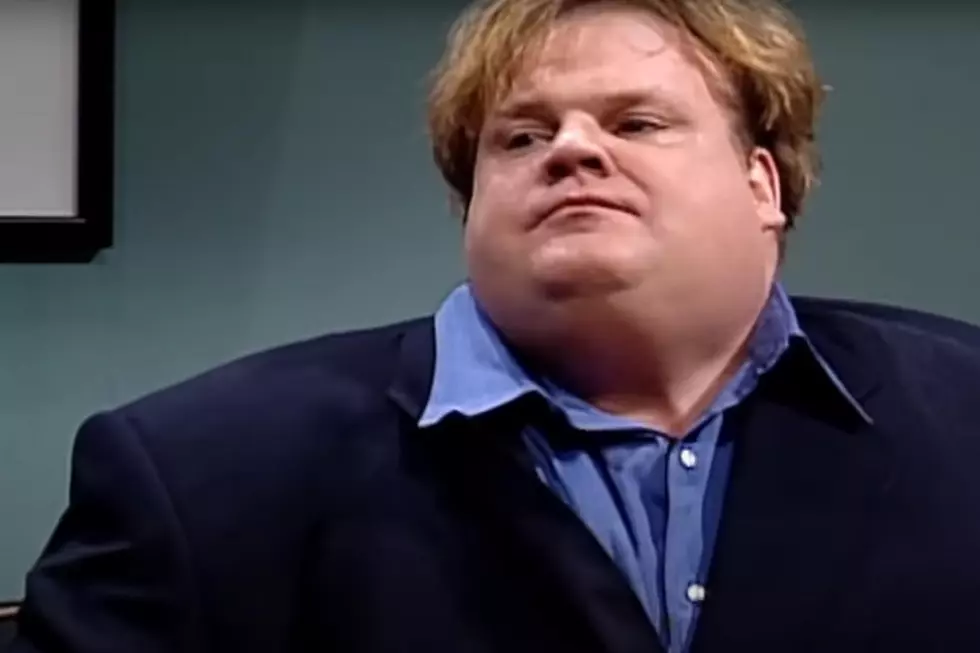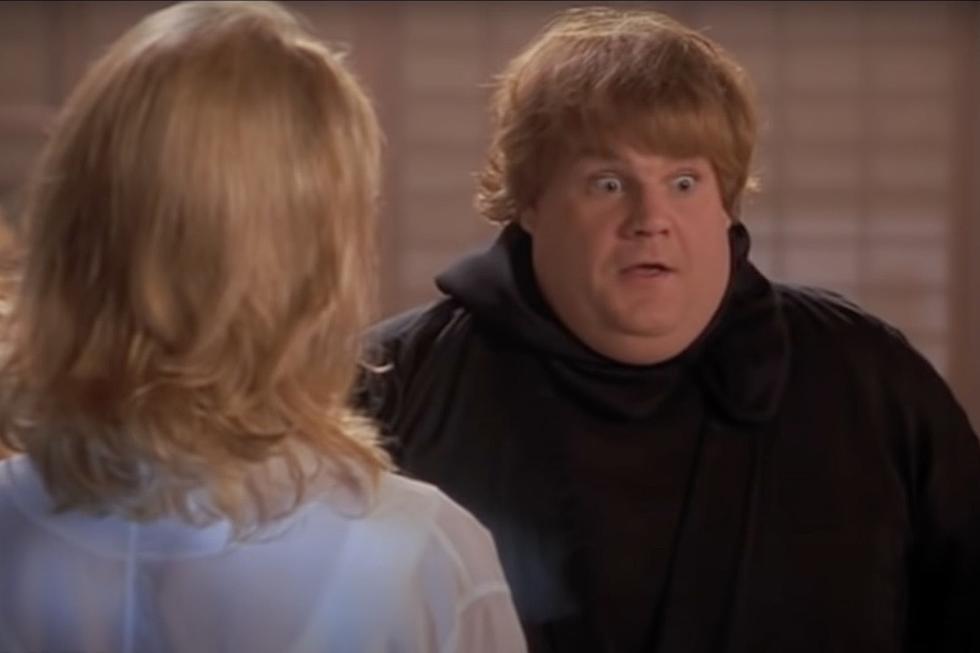
25 Years Ago: Chris Farley’s Last ‘SNL’ Appearance Before His Death
There’s a lot of the Oct. 25, 1997, episode of Saturday Night Live missing from the official version available online. Apart from music-rights issues (no Mighty Mighty Bosstones), there are four full sketches (including one representing the first-ever sketch penned by rookie writer Tina Fey) missing from the streaming episode, all of them centered on that night’s host, Chris Farley.
In retrospect, it might have been advisable to shut down SNL for the night, or for Farley’s pal and former castmate Chris Rock to do more than just make a cameo in the monologue. Rock had been secretly brought in by producer Lorne Michaels as a contingency plan, one of many circulated backstage in the week before Farley took the stage for what would turn out to be the last time. On an episode centered almost exclusively on overt references to the troubled comedian’s very evident struggles with addiction, Farley can be seen out of breath, covered in sweat and notably hoarse after blowing out his voice in dress rehearsal. In less than two months, Farley would be found dead in his Chicago apartment, a combination of heart disease and an overdose of cocaine and morphine ending the comic’s life at 33.
Watching Farley’s final hosting stint now evokes a complicated series of emotions. While it’s unnerving to watch the winded and flushed Farley perform his signature style of boisterous physical comedy - complete with faked heart attacks, huge pratfalls and red-faced bellowing - there’s no question that, for lifelong Saturday Night Live worshipper Farley, he’s exactly where he wants to be.
After he, along with friend Adam Sandler and many others, were fired from the critically floundering show in 1995, Farley found plenty of Hollywood success, but all who knew the Chicago-born comedian stated that being on Saturday Night Live was Farley’s true dream. That Farley specifically idolized original Not Ready for Prime Time Player John Belushi is especially eerie, considering that Farley followed his idol to the grave in strikingly similar circumstances.
Certainly, there’s an unseemly tinge to the show’s cold open and monologue, focused as they are on the very real premise that nobody could be sure whether or not Farley would be in any shape to anchor the show. Tim Meadows - then in his eighth season after debuting alongside Farley, Sandler, and Rock - opens the show in Michaels’ office assuring the fretful producer that his friend is “calm” and “focused,” before Farley himself enters to repeatedly plead his case.
Swayed by Farley’s effusive pleading and a thunderous pratfall (and the questionable joke that fellow SNL alum and substance abuse survivor Chevy Chase is Farley’s sponsor), Michaels allows the show to go forward, only for the monologue stage to remain empty after the band finishes the opening theme. Cut to Farley chomping down grapes while lounging on what turns out to be cast member Ana Gasteyer’s couch. (“Eww,” Gasteyer blurts upon hearing that her dressing room used to be Farley’s.)
Watch Chris Farley's Monologue From His Final 'SNL' Appearance
In the end, Farley (after an offscreen quickie with Gasteyer) makes it to the stage, where both Meadows and the visiting Rock are preparing to host the show instead. Gasteyer references Farley’s “surprising athleticism” in her pep talk to get Farley out there, but by this point in his short life, Farley’s excesses have all too evidently taken hold, with the comic often out of breath, stumbling over occasional lines and even his most popular characters’ broad actions greeted with something akin to unease more than uproarious laughter.
Looking back, castmate Norm Macdonald recalls being upset that the inevitable recurrence of Farley’s bruisingly physical Matt Foley character involved Farley having to ride a stationary bike for much of the sketch, and, indeed, there’s a moment where Farley, after chugging an entire pot of coffee as part of Foley’s routine, pauses in seemingly unscripted distress before continuing. During his "Weekend Update," Macdonald follows up a joke that bombs by urging the audience to laugh anyway, “‘cause it helps Farley get a little rest.”
In the sketches still available to watch, Farley is similarly both game for anything and struggling with everything. A case of the flesh failing to match the will, Farley hurls himself into Matt Foley, a pre-taped sketch revisiting the Chicago Bears-mad superfans and, late in the episode, El Nino, the destructive weather system refashioned as a shirtless, bombastic pro wrestler. It’s the Farley people want to see (“Fatty fall down, ratings go up,” Meadows advises Lorne in the cold open), but the sheer preponderance of jokes about him overexerting himself while suffering through repeated heart attacks as superfan Todd (even having paramedics strip his shirt to apply electric shocks) is a tough watch.
The excised sketches are puzzling in their exclusion from what’s become the official record. Matching up Farley with Molly Shannon’s similarly pratfall-prone Mary Katherine Gallagher was a no-brainer, although it’s Shannon who goes for it when their high school outcasts inevitably crash around the stage, with Farley’s falls feeling tentative in comparison. Still, there’s a matching sweetness to the duo as their wallflowers share a tender little dance before the carnage breaks loose.
Farley channels disgraced former Monday Night Football country crooner Hank Williams Jr., whose sloppy drunkenness is yet another queasy instance of SNL leaning into Farley’s personal life for laughs. That said, there’s a strangely affecting turn when Williams (or Bocephus, as he demands to be called) scolds the disdainful recording technicians for judging him and his “rowdy friends,” allowing Farley to end the sketch on another note of the gentleness that was the true core of even his most histrionic characters.
As for Fey’s first aired sketch, the concept of having Farley come out in his underpants and a T-shirt as a giant, rampaging baby (at one point playfully ripping the arms off of Meadows’ doctor) is the sort of knockabout physical schtick Farley loved doing. Farley was infamously torn about how his physical stature was employed in his comedy, with friend David Spade noting in the Live From New York oral history that Farley’s breakthrough shirtless dancing in the famous “Chippendales” sketch left a lasting psychological mark. Still, when Farley gets into a big, splashy role such as a mammoth, destructive toddler, it’s easy to remember how infectious the pleasure was in watching him do his thing. There’s a joyfulness to this silly sketch that makes its omission from the official record especially disappointing.
In the end, enjoyment of this Season 23 episode demands viewers weigh a lot of factors. Farley loved Saturday Night Live and wanted to be that night’s host and share the monologue stage with pals Rock and Meadows. And while some of the writing decisions remain of questionable taste, it’s also undeniable that SNL, Michaels and those around him at the show refused to repeat the mistakes made in allowing Belushi’s self-destructiveness to proceed unimpeded.
Farley was repeatedly suspended from the show after being given the ultimatum of rehab or being fired. Farley’s friend Bob Odenkirk (who wrote the Matt Foley sketches with Farley), while never a fan of Michaels during his short stint as a writer at SNL, is effusive in Live From New York that Michaels was incredibly invested in putting Farley’s health before the needs of his show. Still, watching the always up-for-anything Farley thrash dutifully about on his last Saturday Night Live appearance is to watch the barreling approach of a sad inevitability.



